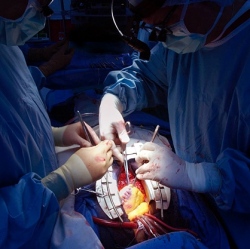
A new device can keep a heart pumping outside the body. The OCS Heart, also known as the “heart in a box,” was developed by Transmedics as a way to enable more heart transplants for patients. The device uses a technique called warm perfusion to keep a heart supplied with blood and oxygen for up to eight hours.
That’s roughly double the viability time of a heart kept on ice. In addition to keeping a donor heart viable longer, the OCS Heart may allow doctors to be less picky about which hearts can be transplanted.
Currently, donor hearts come from patients who are brain-dead. That is, their bodies can function with the help of a ventilator, but brain activity has ceased. The patient’s heart is still beating and still being supplied with blood and oxygen.
Surgeons cool the organ to a few degrees above freezing, then remove it and place it on ice to be rushed to the transplant recipient. At this temperature, the metabolic rate of the cells within the heart is reduced by 90 percent, slowing deterioration.
In many cases, the dying patient’s body can’t be maintained through a ventilator, and the heart stops beating. These organs are not usually used for transplant. By the time the heart stops, the tissue is starved of oxygen, causing the cells to deteriorate quickly.
Putting it on ice wouldn’t be enough to keep the heart viable. That’s where the OCS Heart comes in. With a fresh supply of oxygenated blood, the heart can start beating again, sometimes even on its own. The tissue is reinvigorated, and deterioration is put on hold.
The ability to use hearts that have stopped beating for transplant could dramatically increase the number of donor organs available. Estimates suggest that the OCS Heart could increase the number of heart transplants by 30 percent, saving hundreds of lives.
Right now there simply aren’t enough hearts for everyone who needs them. Only 2,400 heart transplants are performed in the U.S. each year, and that figure has been stagnant for two decades.
